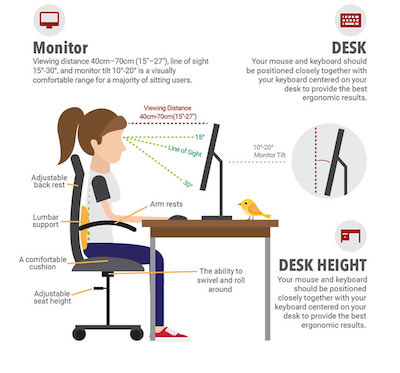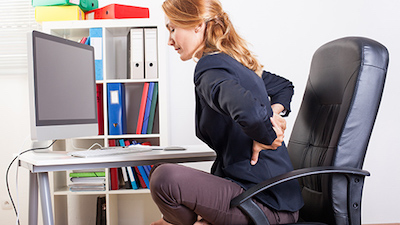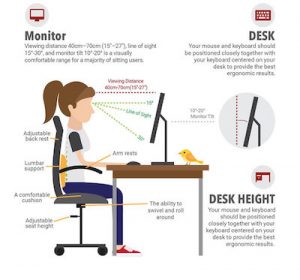How To Guide About Office Ergonomics
There’s no question that a comfortable workspace area can help you feel the best and more productive. The truth is that the more time you spend at the office, the more prone you are to start feeling its effects on your back, neck, and even on your wrists and fingers.
Discover the best office chairs for you.

Overall speaking, good office ergonomics can help you stay comfortable throughout the day. Besides, you can be sure that your body will also approve your decision.
Table of Contents
How To Guide About Office Ergonomics
#1: Office Chair:

When you are thinking about office ergonomics, the first element you need to remember is the office chair.
Overall speaking, you should try to find an office chair that supports your spinal curves. Make sure that you adjust it to ensure that your feet are always flat on the ground as well as your arms gently rest on the armrests.
Discover the best office chairs under 200.
#2: Key Office Objects:
Working in an office implies working with some office supplies and other objects such as stapler, telephone, and printed materials. So, just think about what objects you use more frequently throughout the day and try to maintain them all close to you.
#3: Keyboard And Mouse:

In case you tend to spend a lot of time typing on your computer, then you need to make sure that both your keyboard and mouse are easy to reach and on the same surface.
While typing or using your mouse, keep your wrists straight, your upper arms close to your body, and your hands at or slightly below the level of your elbows. Use keyboard shortcuts to reduce extended mouse use.
If possible, adjust the sensitivity of the mouse so you can use a light touch to operate it. Alternate the hand you use to operate the mouse by moving the mouse to the other side of your keyboard.
Take a look at these office chairs for lower back pain.
#4: Telephone:
Some office workers spend a lot of time on the telephone. If this is your case and you also need to type or write at the same time, then you should consider placing your phone on speaker or simply use a headset. This will prevent you from cradling the phone between your head and neck.
#5: Footrest:
We already mentioned above that your feet should always be flat on the ground. However, if you are a short person and you can reach the floor even with your seat height at the minimum, then you should consider using a footrest. In case you don’t have one, you can also use a stack of sturdy books or even a small stool.
These are the best reclining office chairs with footrest.
#6: Desk:
Up until now, we focused almost all energies in your upper body. But your lower body is also important. The truth is that you should always make sure that you have enough room under your desk for your knees, thighs, and feet.
#7: Setting Up Your Monitor:

As you probably already know, your monitor needs to be well-positioned to maintain proper office ergonomics.
Place the monitor directly in front of you, about an arm’s length away. The top of the screen should be at or slightly below eye level. The monitor should be directly behind your keyboard. If you wear bifocals, lower the monitor an additional 1 to 2 inches for more comfortable viewing. Place your monitor so that the brightest light source is to the side.




